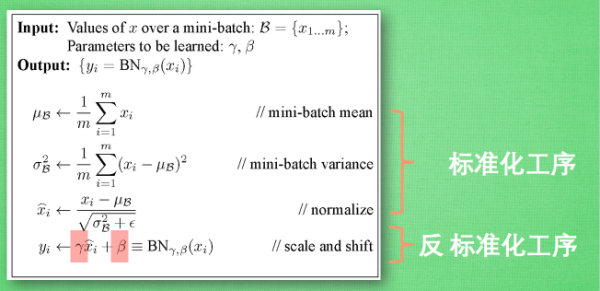tensorflow 批标准化Batch_normalization
来源:互联网 发布:csol死神辅助源码 编辑:程序博客网 时间:2024/06/05 11:27
参考链接:https://morvanzhou.github.io/tutorials/machine-learning/tensorflow/5-13-A-batch-normalization/
首先介绍标准化操作:
平均值为
标准差为
一般在数据处理之前,对数据做标准化操作。在神经网络中,也可以对隐藏层中的数据进行标准化
举一个比较简单的实例:
在一批数据中,x1=1,x2=20,经过全连接层,Wx1=0.1*1=0.1 Wx2=0.1*20=2,再经过tanh激励函数,tanh(0.1)≈0.1,tanh(20)≈0.96,
近于 1 的部已经处在了 激励函数的饱和阶段, 也就是如果 x 无论再怎么扩大, tanh 激励函数输出值也还是 接近1. 换句话说, 神经网络在初始阶段已经不对那些比较大的 x 特征范围 敏感了.
BN(batch_normalization)算法
可以使用batch_normalization对隐藏层的数据进行标准化,BN算法下图所示: normalize 后的数据再进行扩展和平移,对γ和 β参数进行反向传播学习,使得处理后的数据达到最佳的使用效果

ε是为了防止参数为0
参数反向传播证明:http://blog.csdn.net/UESTC_C2_403/article/details/77365813
实践BN算法:
(1)tf.train.ExponentialMovingAverage(decay, steps) 参考链接:http://blog.csdn.net/uestc_c2_403/article/details/72235334
tf.train.ExponentialMovingAverage这个函数用于更新参数,就是采用滑动平均move average的方法更新参数。这个函数初始化需要提供一个衰减速率(decay),用于控制模型的更新速度。这个函数还会维护一个影子变量(也就是更新参数后的参数值),这个影子变量的初始值就是这个变量的初始值,影子变量值的更新方式如下:
shadow_variable = decay * shadow_variable + (1-decay) * variable
shadow_variable是影子变量,variable表示待更新的变量,也就是变量被赋予的值,decay为衰减速率。decay一般设为接近于1的数(0.99,0.999)。decay越大模型越稳定,因为decay越大,参数更新的速度就越慢,趋于稳定。
tf.train.ExponentialMovingAverage这个函数还提供了自己动更新decay的计算方式:
decay= min(decay,(1+steps)/(10+steps))
steps是迭代的次数,可以自己设定。
(2)control_dependencies(self, control_inputs) 和 tf.identity(input, name=None) 参考链接:http://blog.csdn.net/winycg/article/details/78820032
(3)实现BN算法的代码 方法如下:一种使用tf.nn,一种使用tf.layers
① 每批batch的mean和var 都会不同, 所以我们可以使用 moving average 的方法记录并慢慢改进 mean和var 的值. 然后将修改提升后的 mean和var 放入 tf.nn.batch_normalization().
y_mean, y_var = tf.nn.moments(y, axes=[0])update_op = tf.train.ExponentialMovingAverage(decay=0.5).apply([y_mean, y_var])with tf.control_dependencies([update_op]):y_mean2, y_var2 = tf.identity(y_mean), tf.identity(y_var)scale = tf.Variable(tf.ones([out_size]))shift = tf.Variable(tf.zeros([out_size]))eposilon = 0.001y = tf.nn.batch_normalization(y, y_mean2, y_var2, shift, scale, eposilon)# 此函数封装如下操作# y = (y - y_mean) / tf.sqrt(y_var + 0.001)# y = y * scale + shift
②高度集成,参考链接:https://tensorflow.google.cn/api_docs/python/tf/layers/batch_normalization
# 其他参数为默认值,momentum是滑动平均参数tf.layers.batch_normalization(x, momentum=0.4, training=True)
线性回归预测
为了测试在BN前后的差距,采用tanh作为激励函数
import tensorflow as tfimport numpy as npimport matplotlib.pyplot as pltfrom PIL import Imagen_train_samples = 2000n_test_samples = 200batch_size = 128epoch = 250lr = 0.03n_input = 1n_hidden = 8hidden_size = 10n_output = 1# pre_activation[]记录每层还没有进行标准化和激励函数的值# layer_input[]记录每层激励函数之后的结果class NN(object): def __init__(self, is_bn=False): # 在类内创建属于自己的计算图 self.gra = tf.Graph() with self.gra.as_default(): self.n_input = n_input self.n_hidden = n_hidden self.n_output = n_output self.hidden_size = hidden_size self.is_bn = is_bn self.x_data = tf.placeholder(tf.float32, [None, self.n_input]) self.y_data = tf.placeholder(tf.float32, [None, self.n_output]) self.is_training = tf.placeholder(tf.bool) self.pre_activation = [] self.w_init = tf.random_normal_initializer(0, 0.1) self.b_init = tf.zeros_initializer() self.layer_input = [] self.pre_activation.append(self.x_data) if self.is_bn: self.layer_input.append( tf.layers.batch_normalization(self.x_data, training=self.is_training)) else: self.layer_input.append(self.x_data) for i in range(self.n_hidden): self.layer_input.append(self.add_layer(self.layer_input[-1], out_size=self.hidden_size, activation_function=tf.nn.tanh)) self.y = tf.layers.dense(self.layer_input[-1], self.n_output, kernel_initializer=self.w_init, bias_initializer=self.b_init) self.loss = tf.losses.mean_squared_error(self.y_data, self.y) # 若操作中存在batch_normalization,滑动平均和滑动方差更新操作存在于GraphKeys.UPDATE_OPS # 训练之前需要先执行更新操作 update_ops = tf.get_collection(tf.GraphKeys.UPDATE_OPS) with tf.control_dependencies(update_ops): self.train_step = tf.train.AdamOptimizer(lr).minimize(self.loss) init = tf.global_variables_initializer() self.sess = tf.Session(graph=self.gra) self.sess.run(init) def add_layer(self, x, out_size, activation_function=None): x = tf.layers.dense(x, out_size, kernel_initializer=self.w_init, bias_initializer=self.b_init) self.pre_activation.append(x) if self.is_bn: x = tf.layers.batch_normalization(x, momentum=0.4, training=self.is_training) if activation_function is None: output = x else: output = activation_function(x) return output def run_train_step(self, tf_x, tf_y, is_train): self.sess.run(self.train_step, feed_dict={self.x_data: tf_x, self.y_data: tf_y, self.is_training: is_train}) def run_out(self, tf_x, is_train): return self.sess.run(self.y, feed_dict={self.x_data: tf_x, self.is_training: is_train}) def run_loss_input(self, tf_x, tf_y, is_train): return self.sess.run([self.loss, self.layer_input, self.pre_activation], feed_dict={self.x_data: tf_x, self.y_data: tf_y, self.is_training: is_train})# 产生train数据train_x = np.linspace(-7, 10, n_train_samples)[:, np.newaxis]# 产生数据之后要打乱一下,否则神经网络每次学习的是一段局部曲线,# 而每段曲线之间可能是差异很大的,就会影响神经网络的判断np.random.shuffle(train_x)noise = np.random.normal(0, 0.2, train_x.shape)train_y = np.square(train_x) + noise# 产生test数据test_x = np.linspace(-7, 10, n_test_samples)[:, np.newaxis]noise = np.random.normal(0, 0.2, test_x.shape)test_y = np.square(test_x) + noise# 随机获取数据def get_random_data_block(data_x, data_y, data_batch_size): index = np.random.randint(0, len(data_x) - data_batch_size) return data_x[index: index + data_batch_size], data_y[index: index + data_batch_size]# 建立用于对比的神经网络nn_bn = NN(is_bn=True)nn = NN(is_bn=False)fig, axes = plt.subplots(4, n_hidden + 1, figsize=(10, 7), dpi=60)def plot_histogram(l_in, l_in_bn, pre_ac, pre_ac_bn): for i in range(n_hidden + 1): # 清空 for j in range(4): axes[j][i].clear() # if i == 0: p_range = (-7, 10) the_range = (-7, 10) else: p_range = (-4, 4) the_range = (-1, 1) axes[0, i].set_title('L' + str(i)) axes[0, i].hist(pre_ac[i].ravel(), bins=10, range=p_range, alpha=0.75) axes[1, i].hist(pre_ac_bn[i].ravel(), bins=10, range=p_range, alpha=0.75) axes[2, i].hist(l_in[i].ravel(), bins=10, range=the_range, alpha=0.75) axes[3, i].hist(l_in_bn[i].ravel(), bins=10, range=the_range, alpha=0.75) # 将坐标轴的标识清空 for j in range(4): axes[j, i].set_yticks(()) axes[j, i].set_xticks(()) axes[1, i].set_xticks(p_range) axes[3, i].set_xticks(the_range) axes[2, 0].set_ylabel('ACT') axes[3, 0].set_ylabel('ACT_BN') plt.pause(0.01) # 保存每次出现的图像,以便生成gif global gif_image_num gif_image_num += 1 plt.savefig(str(gif_image_num) + '.jpg')losses = []losses_bn = []gif_image_num = 0for k in range(epoch): print(k) batch_x, batch_y = get_random_data_block(train_x, train_y, batch_size) nn.run_train_step(batch_x, batch_y, True) nn_bn.run_train_step(batch_x, batch_y, True) if k % 10 == 0: loss, layer_in, pre_activation = nn.run_loss_input(test_x, test_y, False) loss_bn, layer_in_bn, pre_activation_bn = nn_bn.run_loss_input(test_x, test_y, False) losses.append(loss) losses_bn.append(loss_bn) plot_histogram(layer_in, layer_in_bn, pre_activation, pre_activation_bn)plt.tight_layout()# 利用PIL库生成gif# http://pillow.readthedocs.io/en/latest/handbook/image-file-formats.html#savingbegin_image = Image.open('1.jpg')images = []for num in range(gif_image_num): if num == 0: continue images.append(Image.open(str(num) + '.jpg'))begin_image.save('BN.gif', save_all=True, append_images=images, duration=100)# 绘制loss曲线plt.figure(2)plt.plot(losses, label='NN')plt.plot(losses_bn, label='NN_BN')plt.ylabel('loss')plt.legend()# 绘制预测曲线pred = nn.run_out(test_x, False)pred_bn = nn_bn.run_out(test_x, False)plt.figure(3)plt.plot(test_x, pred, lw=3, label='NN')plt.plot(test_x, pred_bn, lw=3, label='NN_BN')plt.scatter(test_x, test_y, s=10, color='red', alpha=0.3)plt.legend()plt.show()查看输出值的分布:
误差曲线:
测试数据:
- tensorflow 批标准化Batch_normalization
- Tensorflow batch_normalization
- tensorflow.layers.batch_normalization使用方法
- 3.1 Tensorflow: 批标准化(Batch Normalization)
- tensorflow:批标准化(Bacth Normalization,BN)
- tensorflow图片归一化之tf.layers.batch_normalization/tf.nn.batch_normalization/tf.contrib.layers.batch_norm
- tensorflow学习——tf.layers.batch_normalization/tf.nn.batch_normalization/tf.contrib.layers.batch_norm
- tensorflow-BatchNormalization(tf.nn.moments及tf.nn.batch_normalization)
- [TensorFlow 学习笔记-05]批标准化(Bacth Normalization,BN)
- tensorflow 的 Batch Normalization 实现(tf.nn.moments、tf.nn.batch_normalization)
- tensorflow下的图片标准化函数per_image_standardization
- 学习笔记TF048:TensorFlow 系统架构、设计理念、编程模型、API、作用域、批标准化、神经元函数优化
- Tensorflow实战学习(四十八)【系统架构,设计理念,编程模型,API,作用域,批标准化,神经元函数优化】
- pytorch Batch Normalization批标准化
- 17批标准化(Batch Normalization )
- 万维网标准化
- 标准化基础知识
- 万维网标准化
- Java实现邮箱验证码
- 使用Microsoft的ClickOnce发布版本及网页更新版本
- Java四种线程池的用法分析
- android EditText输入四位数字密码明文显示
- 加载数据(glide)
- tensorflow 批标准化Batch_normalization
- SpringBoot入门-2(HelloWorld)
- HAWQ安装方式之RPM包安装
- java keytool证书工具使用小结
- 网站引导页插件intro.js 的用法
- 安装好Protege4.3后 无法启动,什么鬼
- vue购物车总价计算
- AIX 系统介绍
- 前端的精灵图制作以及精灵图定位









